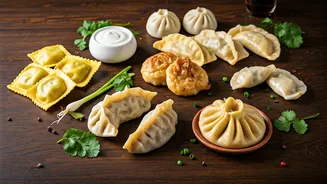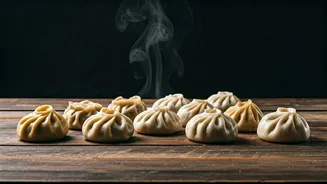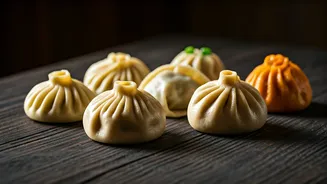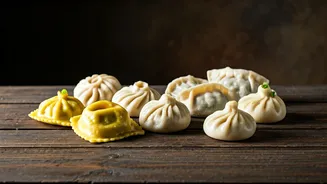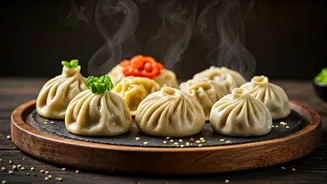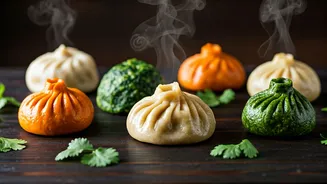Italian Ravioli's Charm
Ravioli, a cornerstone of Italian cuisine, showcases the artistry of pasta making. These small, pillow-shaped dumplings are typically filled with a medley
of ingredients, including cheese, meat, or vegetables, each contributing its unique flavor profile. The thin pasta encasing the filling creates a delightful contrast in textures. Originating in Italy, ravioli has evolved over centuries, with regional variations showcasing local ingredients. They are traditionally served in a light sauce, like butter and sage, or a rich tomato sauce, allowing the delicate flavors of the filling to shine. The preparation itself is a testament to Italian craftsmanship, highlighting a focus on fresh ingredients and time-honored techniques. The joy of eating ravioli comes from the seamless integration of flavors and textures, making it a classic comfort food that continues to enchant people all over the world.
Chinese Jiaozi Delights
Jiaozi, often called Chinese dumplings, are a staple food in China, especially during the Lunar New Year. Their crescent shape is said to resemble ancient Chinese money, signifying prosperity. Jiaozi typically feature a savory filling, which could be anything from seasoned ground meat and vegetables to seafood or tofu, encased in a thin dough. They can be cooked in various ways: boiled (shui jiao), steamed (zheng jiao), or pan-fried (jian jiao). Each cooking method offers a different texture, adding versatility to the dish. Dipping sauces, ranging from soy sauce and vinegar to chili oil, further enhance the flavor experience, allowing for customization to individual preferences. The act of making and eating jiaozi is a communal activity, representing family togetherness and shared enjoyment. Whether enjoyed as a snack or a meal, jiaozi's simple yet satisfying nature has made it a favorite across generations.
Russian Pelmeni's Heartiness
Pelmeni, the heart-warming dumplings of Russia, are known for their simplicity and satisfying nature. These small, meat-filled dumplings, often made with a mixture of pork, beef, or lamb, are wrapped in a thin, unleavened dough. The meat is typically seasoned with onions, garlic, and spices. After being shaped into a small, round form, they are boiled in water until they float, a clear sign of their readiness. Traditionally, pelmeni are served with sour cream, butter, or vinegar, allowing their savory flavor to shine. They're a staple during the cold Russian winters, providing warmth and comfort. The simplicity of ingredients belies the complexity of flavor, making pelmeni a testament to the art of comfort food. Pelmeni's portability makes it ideal for different lifestyles, from a quick meal to a centerpiece for a festive gathering.
Japanese Gyoza's Crispness
Gyoza, the pan-fried dumplings of Japan, boast a perfect combination of crispy bottoms and juicy fillings. The typical filling is ground meat (usually pork) mixed with vegetables like cabbage and garlic chives, along with other seasonings. After being filled, they're pan-fried to golden perfection on one side, then steamed to cook the filling completely. This cooking process gives gyoza their distinctive texture. Often served with a dipping sauce of soy sauce, rice vinegar, and chili oil, gyoza offer a delightful balance of flavors and textures. The art of preparing gyoza is evident in the carefully crafted folds, which not only enhance the visual appeal but also contribute to the even cooking of the filling. Gyoza's versatility, from a side dish to a main course, makes it a popular choice in Japanese cuisine and throughout the world.
Nepali Momo's Spices
Momo, the steamed dumplings of Nepal and Tibet, bring a world of aromatic spices and delicious fillings. The dumplings typically consist of a meat or vegetable filling, which can range from finely ground yak meat or chicken to potatoes and cabbage. This is encased in a simple, wheat-flour dough. The steaming process tenderizes the dough and cooks the filling to perfection. Momo is served with a variety of sauces, most commonly a fiery chili sauce or a milder tomato-based dip, adding a layer of complexity to the overall eating experience. Momo is a cultural staple, often enjoyed during festivals and gatherings, symbolizing community and sharing. The diverse range of fillings and sauces means that momo provides a range of tastes to satisfy any palate, adding to the culinary diversity.
Polish Pierogi's Variety
Pierogi, the delicious dumplings of Poland, demonstrate the versatility of dough and fillings. Their semi-circular shape is a familiar sight in Polish homes and restaurants. The dough, made from flour, water, and sometimes eggs, is filled with a wide range of ingredients including potatoes, cheese, sauerkraut, or meat. These dumplings are typically boiled, then pan-fried or baked, lending them a pleasing texture. Served with a dollop of sour cream and fried onions, pierogi are a comforting dish, embodying the warmth of Polish cuisine. Regional variations abound, with different fillings and preparations, showcasing the adaptability and tradition within Polish culture. Pierogi remains a timeless dish, perfect for satisfying hungry appetites and celebrating the richness of Polish culinary heritage.
